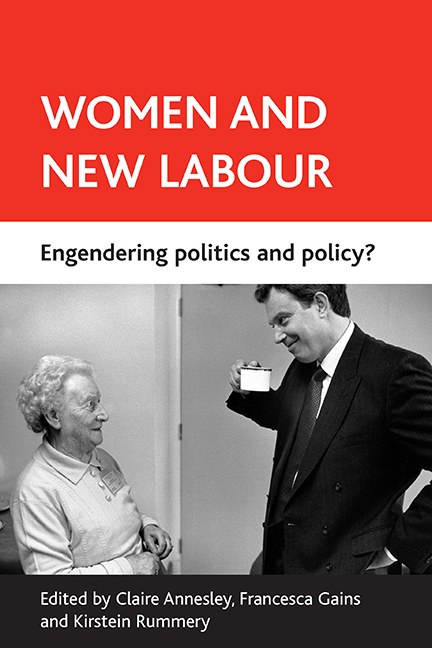four - Framing claims for women: from ‘old’ to ‘new’ Labour
Published online by Cambridge University Press: 15 September 2022
Summary
Introduction
As noted in Chapter One, it was the adoption of AWS that secured New Labour's dramatic gender breakthrough in the June 1997 elections, when it virtually trebled the number of women MPs in the Parliamentary Labour Party (PLP) from 37 to 101. The party's resort to this strong measure of positive discrimination was sealed under John Smith's leadership at the party's 1993 Annual Conference, in the immediate aftermath of the party's fourth successive electoral defeat in 1992 (Short 1996, 19-21; Russell 2005, 111-5). Crucially, what AWS offered was a means of operationalising gender quotas within the framework of the UK's single-member constituency, first-past-the-post (FPTP) electoral system. In adopting AWS, the 1993 Conference committed the party to achieving a 50% quota in two categories of winnable seats: vacant safe seats, where a Labour MP was retiring at the next election; and the party's target marginals that it needed to win if it was to secure a working majority.
In the event, an industrial tribunal ruling (discussed further later) in January 1996 forced the party to abandon this procedure before it had completed its countrywide selection process. Nevertheless, as Table 4.1 shows, the bulk (35) of the party's 54 women MPs elected in these two categories of seats owed their selection to AWS; while a further seven were beneficiaries of ‘informal’ AWS procedures concluded after the tribunal ruling. The result was that whereas women comprised just 15% of the incumbent Labour MPs re-elected in June 1997 and 17% of the MPs elected in the ‘surprise-gain’ category, where AWS had not been implemented, in its non-incumbent safe and target seats the party was able to achieve women candidacy levels of 34% and 51% respectively and went on to win all of these seats.
AWS was devised and adopted as the post-1992 sequel to a much larger ‘package’ of gender reforms within the party's internal organisation that had been put together in the latter years of Neil Kinnock's leadership, following the party's previous defeat in 1987. Adopted at the Party's Annual Conferences between 1989 and 1992, these reforms introduced an extensive, rolling programme of mandatory gender quotas (of between 40% and 50%) for positions of responsibility at all levels of the party:
- Type
- Chapter
- Information
- Women and New LabourEngendering Politics and Policy?, pp. 63 - 92Publisher: Bristol University PressPrint publication year: 2007
- 1
- Cited by



